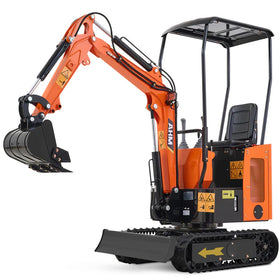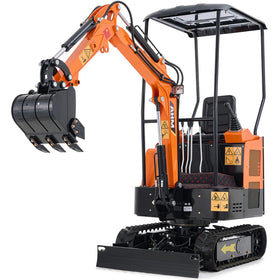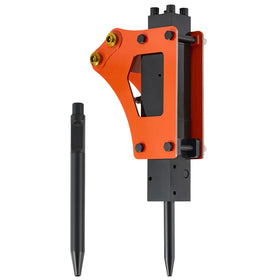Think the mini excavator hydraulic system problems you’re having are just bad luck? Well, it’s deeper than that. According to industry data, 80-90% of hydraulic failures come from contamination alone, and most owners find this out the hard way when a simple seal leak leads to a $3,000 pump replacement.
The mini excavator hydraulic system is what makes your 2,200-pound machine generate over 2,500 lbs of digging force. Without it, you've got an expensive paperweight. But here's what most people don't realize - these systems run at crazy high pressures and fail in predictable ways on most occasions. Understanding how they work isn't rocket science, but it can save you thousands in the long run.

What Does the Mini Excavator Hydraulic System Do?
The mini excavator hydraulic system converts engine power into precise movements to get actual work done. Think of it as your machine's muscular system, but instead of tendons and bones, you've got pressurized oil flowing through hoses at 3,000-5,000 PSI.
Most mini excavators run in these pressure ranges:
- 1-ton machines: 3,130-3,555 PSI
- Larger models: Up to 4,980 PSI during normal operations
- Power boost modes: 5,260 PSI for 10-15 seconds
The hydraulic system handles multiple jobs at once - boom lift, bucket curl, track movement, and swing rotation. Each function needs different pressure and flow rates, which is why hydraulic problems are so common and run the risk of shutting down your entire operation.
Components of Mini Excavator Hydraulic System
The mini excavator hydraulic system is made up of multiple components that work in harmony. A failure in any one of these can grind your work to a halt.
1. The Hydraulic Tank
- Stores 12-14 gallons of hydraulic fluid in most 1-ton machines
- Heat management by absorbing heat to prevent overheating (fluid above 140°F kills system components fast)
- Contamination control: Deposits debris at the bottom to keep it out of circulation
2. Hydraulic Pump
Two main types of hydraulic pumps show up in modern mini excavators:
i. Gear Pumps
- Good enough for 1-ton machines
- Cheaper to replace, at $800-1,500
- Flow rates around 15-25 GPM
ii. Piston Pumps
- Required for 2-ton+ machines
- More expensive ($2,000-4,000)
- Higher flow rates of 30-44 GPM
- Better at handling pressure
3. Directional Control Valves
- Has a closed-center design so that there is no fluid flow unless you move a lever
- Reduces operator effort
- Has the capability to run several operations simultaneously without interference
4. Relief Valves
- Releases excess pressure before it destroys the pumps and cylinders
5. Hydraulic Cylinders
Force output comes from a simple formula: Pressure × Piston Area = Force
- Rod diameter affects speed: Larger rods are slower to extend, and faster to retract
- The stroke length determines maximum reach and lift height

How Mini Excavator Hydraulic Systems Work: Step by Step
Step 1: Pressure Generation
The engine drives a hydraulic pump, creating flow. The pump squeezes fluid through the lines, and pressure builds when it hits resistance - like when lifting a load.
Step 2: Flow Distribution
The main control valve directs pressurized fluid to individual cylinders:
- Boom up: Fluid goes to the bottom of the boom cylinder
- Bucket curl: Fluid flows to the bucket cylinder
- Track movement: Fluid powers final drive motors
Step 3: Force Multiplication
A small pump creates flow, but force comes from cylinder size. Hence, the same pressure levels can give different results.
- 2-inch cylinder at 3,000 PSI = 9,400 lbs of force
- 4-inch cylinder at 3,000 PSI = 37,700 lbs of force
Step 4: Return Flow
Used fluid returns to the tank through filters. The system maintains pressure through a relief valve that opens at the maximum setting.
Step 5: Heat Dissipation
Fluid circulation helps to cool the system. Overworked systems generate excessive heat that breaks down fluid and may damage components.

Why Are Hydraulics Important for Mini Excavators?
Power Density
Hydraulics deliver the highest power-to-weight ratio available:
- For example, the 2,200-lb AX-15 generates 2,698 lbf of digging force, which is more force than the machine weighs
- Electric or mechanical systems simply can't match this
Precision Control
Hydraulic systems enable millimeter-precise movements:
- Variable flow control: Adjust the speed from crawl to full speed
- Proportional operation: Lever movement directly controls cylinder speed
- Smooth operation: No jerky movements that may damage worksite materials
Attachment Versatility
Different attachments need different hydraulic requirements:
- Hydraulic breakers: 15-25 GPM, high pressure
- Augers: 10-15 GPM, moderate pressure
- Mulchers: 20+ GPM, variable pressure
- Grapplers: 8-12 GPM, moderate pressure
Reliability in Tough Conditions
Hydraulic systems can handle:
- Extreme temperatures: -20°F to 150°F operating range
- Shock loads: Sudden impacts don't damage the system
- Contaminated environments: Sealed system keeps dirt out

AHM High Quality Mini Excavators
1. AHM AX-12B - $5,899.99
The AX-12B 13.5 HP Mini Excavator delivers some serious performance with its 13.5 HP Briggs & Stratton engine driving a precision hydraulic system. This machine generates 2,585 lbf of digging force through its 69-inch maximum digging depth, making it perfect for foundation work where precision matters.
- 2,585 lbf maximum digging force
- 120-inch maximum digging radius
- Enhanced hydraulics support high-flow attachments
2. AHM NW-A1 - $7,399.99
The NW-A1 combines the proven AX-12B’s mini excavator hydraulic system with six essential attachments in one delivery. You get identical hydraulic performance - 2,585 lbf digging force and 69-inch reach - plus immediate compatibility with the included quick hitch, grading bucket, grapple, rake, hydraulic hammer, and auger. This package saves you from having to buy attachments separately at higher individual prices.
- Same hydraulic specs as AX-12B
- Six attachments included for maximum versatility
- Ready to work on day one
The Bottom Line
Understanding your mini excavator hydraulic system isn't about becoming a hydraulic engineer - it's about avoiding expensive failures that shut down your projects. With 80-90% of hydraulic failures caused by contamination, simple maintenance like regular filter changes and having clean fluid prevents most problems.
The numbers don't lie: hydraulic repairs average $2,000-4,000 when pumps fail, but preventive maintenance only costs you under $200 annually. Whether you're running an AX-12B for weekend projects or an AX-15 for daily commercial work, knowing how your hydraulic system works helps you spot problems before they become disasters.
So, keep your fluid clean, monitor temperatures, and take care of small leaks immediately. Your hydraulic system will reward you with years of reliable service and the power to tackle any job that comes your way.







